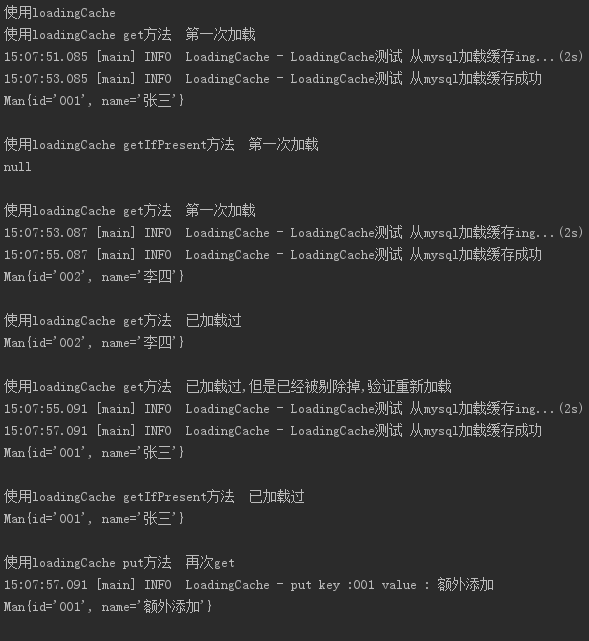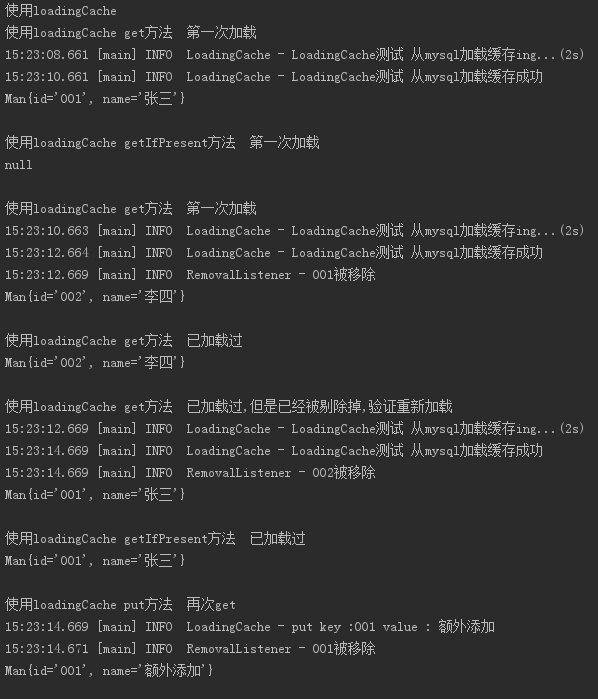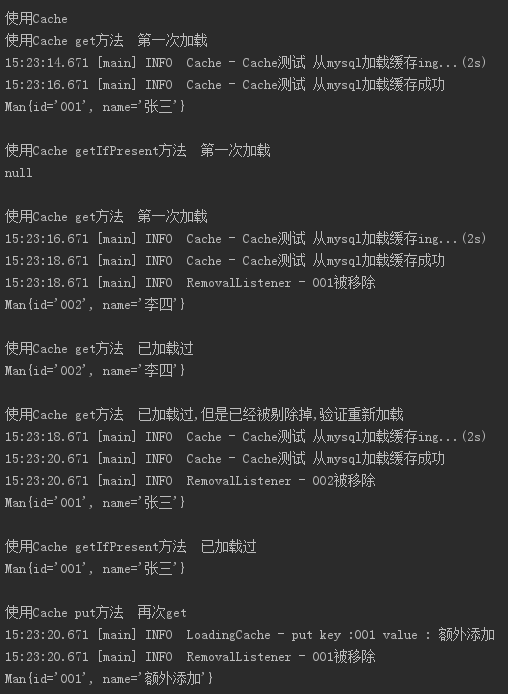Guava学习:Cache缓存入门
摘要: 学习Google内部使用的工具包Guava,在Java项目中轻松地增加缓存,提高程序获取数据的效率。
一、什么是缓存?
根据科普中国的定义,缓存就是数据交换的缓冲区(称作Cache),当某一硬件要读取数据时,会首先从缓存中查找需要的数据,如果找到了则直接执行,找不到的话则从内存中找。由于缓存的运行速度比内存快得多,故缓存的作用就是帮助硬件更快地运行。
在这里,我们借用了硬件缓存的概念,当在Java程序中计算或查询数据的代价很高,并且对同样的计算或查询条件需要不止一次获取数据的时候,就应当考虑使用缓存。换句话说,缓存就是以空间换时间,大部分应用在各种IO,数据库查询等耗时较长的应用当中。
二、缓存原理
当获取数据时,程序将先从一个存储在内存中的数据结构中获取数据。如果数据不存在,则在磁盘或者数据库中获取数据并存入到数据结构当中。之后程序需要再次获取数据时,则会先查询这个数据结构。从内存中获取数据时间明显小于通过IO获取数据,这个数据结构就是缓存的实现。
这里引入一个概念,缓存命中率:从缓存中获取到数据的次数/全部查询次数,命中率越高说明这个缓存的效率好。由于机器内存的限制,缓存一般只能占据有限的内存大小,缓存需要不定期的删除一部分数据,从而保证不会占据大量内存导致机器崩溃。
如何提高命中率呢?那就得从删除一部分数据着手了。目前有三种删除数据的方式,分别是:FIFO(先进先出)、LFU(定期淘汰最少使用次数)、LRU(淘汰最长时间未被使用)。
三、GuavaCache工作方式
GuavaCache的工作流程:获取数据->如果存在,返回数据->计算获取数据->存储返回。由于特定的工作流程,使用者必须在创建Cache或者获取数据时指定不存在数据时应当怎么获取数据。GuavaCache采用LRU的工作原理,使用者必须指定缓存数据的大小,当超过缓存大小时,必定引发数据删除。GuavaCache还可以让用户指定缓存数据的过期时间,刷新时间等等很多有用的功能。
四、GuavaCache使用Demo
4.1 简单使用
有人说我就想简简单单的使用cache,就像Map那样方便就行。接下来展示一段简单的使用方式。
首先定义一个需要存储的Bean,对象Man:
/**
* @author jiangmitiao
* @version V1.0
* @Title: 标题
* @Description: Bean
* @date 2016/10/27 10:01
*/
public class Man {
//身份证号
private String id;
//姓名
private String name;
public String getId() {
return id;
}
public void setId(String id) {
this.id = id;
}
public String getName() {
return name;
}
public void setName(String name) {
this.name = name;
}
@Override
public String toString() {
return "Man{" +
"id='" + id + '\'' +
", name='" + name + '\'' +
'}';
}
}
接下来我们写一个Demo:
import com.google.common.cache.*;
import org.slf4j.Logger;
import org.slf4j.LoggerFactory;
import java.util.concurrent.*;
/**
* @author jiangmitiao
* @version V1.0
* @Description: Demo
* @date 2016/10/27 10:00
*/
public class GuavaCachDemo {
private LoadingCache<String,Man> loadingCache;
//loadingCache
public void InitLoadingCache() {
//指定一个如果数据不存在获取数据的方法
CacheLoader<String, Man> cacheLoader = new CacheLoader<String, Man>() {
@Override
public Man load(String key) throws Exception {
//模拟mysql操作
Logger logger = LoggerFactory.getLogger("LoadingCache");
logger.info("LoadingCache测试 从mysql加载缓存ing...(2s)");
Thread.sleep(2000);
logger.info("LoadingCache测试 从mysql加载缓存成功");
Man tmpman = new Man();
tmpman.setId(key);
tmpman.setName("其他人");
if (key.equals("001")) {
tmpman.setName("张三");
return tmpman;
}
if (key.equals("002")) {
tmpman.setName("李四");
return tmpman;
}
return tmpman;
}
};
//缓存数量为1,为了展示缓存删除效果
loadingCache = CacheBuilder.newBuilder().maximumSize(1).build(cacheLoader);
}
//获取数据,如果不存在返回null
public Man getIfPresentloadingCache(String key){
return loadingCache.getIfPresent(key);
}
//获取数据,如果数据不存在则通过cacheLoader获取数据,缓存并返回
public Man getCacheKeyloadingCache(String key){
try {
return loadingCache.get(key);
} catch (ExecutionException e) {
e.printStackTrace();
}
return null;
}
//直接向缓存put数据
public void putloadingCache(String key,Man value){
Logger logger = LoggerFactory.getLogger("LoadingCache");
logger.info("put key :{} value : {}",key,value.getName());
loadingCache.put(key,value);
}
}
接下来,我们写一些测试方法,检测一下
public class Test {
public static void main(String[] args){
GuavaCachDemo cachDemo = new GuavaCachDemo()
System.out.println("使用loadingCache");
cachDemo.InitLoadingCache();
System.out.println("使用loadingCache get方法 第一次加载");
Man man = cachDemo.getCacheKeyloadingCache("001");
System.out.println(man);
System.out.println("\n使用loadingCache getIfPresent方法 第一次加载");
man = cachDemo.getIfPresentloadingCache("002");
System.out.println(man);
System.out.println("\n使用loadingCache get方法 第一次加载");
man = cachDemo.getCacheKeyloadingCache("002");
System.out.println(man);
System.out.println("\n使用loadingCache get方法 已加载过");
man = cachDemo.getCacheKeyloadingCache("002");
System.out.println(man);
System.out.println("\n使用loadingCache get方法 已加载过,但是已经被剔除掉,验证重新加载");
man = cachDemo.getCacheKeyloadingCache("001");
System.out.println(man);
System.out.println("\n使用loadingCache getIfPresent方法 已加载过");
man = cachDemo.getIfPresentloadingCache("001");
System.out.println(man);
System.out.println("\n使用loadingCache put方法 再次get");
Man newMan = new Man();
newMan.setId("001");
newMan.setName("额外添加");
cachDemo.putloadingCache("001",newMan);
man = cachDemo.getCacheKeyloadingCache("001");
System.out.println(man);
}
}
测试结果如下:

4.2 高级特性
由于目前使用有局限性,接下来只讲我用到的一些方法。
我来演示一下GuavaCache自带的两个Cache
GuavaCacheDemo.java
import com.google.common.cache.*;
import org.slf4j.Logger;
import org.slf4j.LoggerFactory;
import java.util.concurrent.*;
/**
* @author jiangmitiao
* @version V1.0
* @Description: Demo
* @date 2016/10/27 10:00
*/
public class GuavaCachDemo {
private Cache<String, Man> cache;
private LoadingCache<String,Man> loadingCache;
private RemovalListener<String, Man> removalListener;
public void Init(){
//移除key-value监听器
removalListener = new RemovalListener<String, Man>(){
public void onRemoval(RemovalNotification<String, Man> notification) {
Logger logger = LoggerFactory.getLogger("RemovalListener");
logger.info(notification.getKey()+"被移除");
//可以在监听器中获取key,value,和删除原因
notification.getValue();
notification.getCause();//EXPLICIT、REPLACED、COLLECTED、EXPIRED、SIZE
}};
//可以使用RemovalListeners.asynchronous方法将移除监听器设为异步方法
//removalListener = RemovalListeners.asynchronous(removalListener, new ThreadPoolExecutor(1,1,1000, TimeUnit.MINUTES,new ArrayBlockingQueue<Runnable>(1)));
}
//loadingCache
public void InitLoadingCache() {
//指定一个如果数据不存在获取数据的方法
CacheLoader<String, Man> cacheLoader = new CacheLoader<String, Man>() {
@Override
public Man load(String key) throws Exception {
//模拟mysql操作
Logger logger = LoggerFactory.getLogger("LoadingCache");
logger.info("LoadingCache测试 从mysql加载缓存ing...(2s)");
Thread.sleep(2000);
logger.info("LoadingCache测试 从mysql加载缓存成功");
Man tmpman = new Man();
tmpman.setId(key);
tmpman.setName("其他人");
if (key.equals("001")) {
tmpman.setName("张三");
return tmpman;
}
if (key.equals("002")) {
tmpman.setName("李四");
return tmpman;
}
return tmpman;
}
};
//缓存数量为1,为了展示缓存删除效果
loadingCache = CacheBuilder.newBuilder().
//设置2分钟没有获取将会移除数据
expireAfterAccess(2, TimeUnit.MINUTES).
//设置2分钟没有更新数据则会移除数据
expireAfterWrite(2, TimeUnit.MINUTES).
//每1分钟刷新数据
refreshAfterWrite(1,TimeUnit.MINUTES).
//设置key为弱引用
weakKeys().
// weakValues().//设置存在时间和刷新时间后不能再次设置
// softValues().//设置存在时间和刷新时间后不能再次设置
maximumSize(1).
removalListener(removalListener).
build(cacheLoader);
}
//获取数据,如果不存在返回null
public Man getIfPresentloadingCache(String key){
return loadingCache.getIfPresent(key);
}
//获取数据,如果数据不存在则通过cacheLoader获取数据,缓存并返回
public Man getCacheKeyloadingCache(String key){
try {
return loadingCache.get(key);
} catch (ExecutionException e) {
e.printStackTrace();
}
return null;
}
//直接向缓存put数据
public void putloadingCache(String key,Man value){
Logger logger = LoggerFactory.getLogger("LoadingCache");
logger.info("put key :{} value : {}",key,value.getName());
loadingCache.put(key,value);
}
public void InitDefault() {
cache = CacheBuilder.newBuilder().
expireAfterAccess(2, TimeUnit.MINUTES).
expireAfterWrite(2, TimeUnit.MINUTES).
// refreshAfterWrite(1,TimeUnit.MINUTES).//没有cacheLoader的cache不能设置刷新,因为没有指定获取数据的方式
weakKeys().
// weakValues().//设置存在时间和刷新时间后不能再次设置
// softValues().//设置存在时间和刷新时间后不能再次设置
maximumSize(1).
removalListener(removalListener).
build();
}
public Man getIfPresentCache(String key){
return cache.getIfPresent(key);
}
public Man getCacheKeyCache(final String key) throws ExecutionException {
return cache.get(key, new Callable<Man>() {
public Man call() throws Exception {
//模拟mysql操作
Logger logger = LoggerFactory.getLogger("Cache");
logger.info("Cache测试 从mysql加载缓存ing...(2s)");
Thread.sleep(2000);
logger.info("Cache测试 从mysql加载缓存成功");
Man tmpman = new Man();
tmpman.setId(key);
tmpman.setName("其他人");
if (key.equals("001")) {
tmpman.setName("张三");
return tmpman;
}
if (key.equals("002")) {
tmpman.setName("李四");
return tmpman;
}
return tmpman;
}
});
}
public void putCache(String key,Man value){
Logger logger = LoggerFactory.getLogger("Cache");
logger.info("put key :{} value : {}",key,value.getName());
cache.put(key,value);
}
}
在这个demo中,分别采用了Guava自带的两个Cache:LocalLoadingCache和LocalManualCache。并且添加了监听器,当数据被删除后会打印日志。
Main:
public static void main(String[] args){
GuavaCachDemo cachDemo = new GuavaCachDemo();
cachDemo.Init();
System.out.println("使用loadingCache");
cachDemo.InitLoadingCache();
System.out.println("使用loadingCache get方法 第一次加载");
Man man = cachDemo.getCacheKeyloadingCache("001");
System.out.println(man);
System.out.println("\n使用loadingCache getIfPresent方法 第一次加载");
man = cachDemo.getIfPresentloadingCache("002");
System.out.println(man);
System.out.println("\n使用loadingCache get方法 第一次加载");
man = cachDemo.getCacheKeyloadingCache("002");
System.out.println(man);
System.out.println("\n使用loadingCache get方法 已加载过");
man = cachDemo.getCacheKeyloadingCache("002");
System.out.println(man);
System.out.println("\n使用loadingCache get方法 已加载过,但是已经被剔除掉,验证重新加载");
man = cachDemo.getCacheKeyloadingCache("001");
System.out.println(man);
System.out.println("\n使用loadingCache getIfPresent方法 已加载过");
man = cachDemo.getIfPresentloadingCache("001");
System.out.println(man);
System.out.println("\n使用loadingCache put方法 再次get");
Man newMan = new Man();
newMan.setId("001");
newMan.setName("额外添加");
cachDemo.putloadingCache("001",newMan);
man = cachDemo.getCacheKeyloadingCache("001");
System.out.println(man);
///////////////////////////////////
System.out.println("\n\n使用Cache");
cachDemo.InitDefault();
System.out.println("使用Cache get方法 第一次加载");
try {
man = cachDemo.getCacheKeyCache("001");
} catch (ExecutionException e) {
e.printStackTrace();
}
System.out.println(man);
System.out.println("\n使用Cache getIfPresent方法 第一次加载");
man = cachDemo.getIfPresentCache("002");
System.out.println(man);
System.out.println("\n使用Cache get方法 第一次加载");
try {
man = cachDemo.getCacheKeyCache("002");
} catch (ExecutionException e) {
e.printStackTrace();
}
System.out.println(man);
System.out.println("\n使用Cache get方法 已加载过");
try {
man = cachDemo.getCacheKeyCache("002");
} catch (ExecutionException e) {
e.printStackTrace();
}
System.out.println(man);
System.out.println("\n使用Cache get方法 已加载过,但是已经被剔除掉,验证重新加载");
try {
man = cachDemo.getCacheKeyCache("001");
} catch (ExecutionException e) {
e.printStackTrace();
}
System.out.println(man);
System.out.println("\n使用Cache getIfPresent方法 已加载过");
man = cachDemo.getIfPresentCache("001");
System.out.println(man);
System.out.println("\n使用Cache put方法 再次get");
Man newMan1 = new Man();
newMan1.setId("001");
newMan1.setName("额外添加");
cachDemo.putloadingCache("001",newMan1);
man = cachDemo.getCacheKeyloadingCache("001");
System.out.println(man);
}
测试结果如下:


由上述结果可以表明,GuavaCache可以在数据存储到达指定大小后删除数据结构中的数据。我们可以设置定期删除而达到定期从数据库、磁盘等其他地方更新数据等(再次访问时数据不存在重新获取)。也可以采用定时刷新的方式更新数据。
还可以设置移除监听器对被删除的数据进行一些操作。通过RemovalListeners.asynchronous(RemovalListener,Executor)方法将监听器设为异步,笔者通过实验发现,异步监听不会在删除数据时立刻调用监听器方法。
五、GuavaCache结构初探

类结构图
GuavaCache并不希望我们设置复杂的参数,而让我们采用建造者模式创建Cache。GuavaCache分为两种Cache:Cache,LoadingCache。LoadingCache继承了Cache,他比Cache主要多了get和refresh方法。多这两个方法能干什么呢?
在第四节高级特性demo中,我们看到builder生成不带CacheLoader的Cache实例。在类结构图中其实是生成了LocalManualCache类实例。而带CacheLoader的Cache实例生成的是LocalLoadingCache。他可以定时刷新数据,因为获取数据的方法已经作为构造参数方法存入了Cache实例中。同样,在get时,不需要像LocalManualCache还需要传入一个Callable实例。
实际上,这两个Cache实现类都继承自LocalCache,大部分实现都是父类做的。
六、总结回顾
缓存加载:CacheLoader、Callable、显示插入(put)
缓存回收:LRU,定时(expireAfterAccess,expireAfterWrite),软弱引用,显示删除(Cache接口方法invalidate,invalidateAll)
监听器:CacheBuilder.removalListener(RemovalListener)
清理缓存时间:只有在获取数据时才或清理缓存LRU,使用者可以单起线程采用Cache.cleanUp()方法主动清理。
刷新:主动刷新方法LoadingCache.referesh(K)
信息统计:CacheBuilder.recordStats() 开启Guava Cache的统计功能。Cache.stats() 返回CacheStats对象。(其中包括命中率等相关信息)
获取当前缓存所有数据:cache.asMap(),cache.asMap().get(Object)会刷新数据的访问时间(影响的是:创建时设置的在多久没访问后删除数据)
LocalManualCache和LocalLoadingCache的选择
ManualCache可以在get时动态设置获取数据的方法,而LoadingCache可以定时刷新数据。如何取舍?我认为在缓存数据有很多种类的时候采用第一种cache。而数据单一,数据库数据会定时刷新时采用第二种cache。
具体工程中的情况也欢迎大家与我交流,互相学习。
参考资料:
http://www.cnblogs.com/peida/p/Guava_Cache.html
https://github.com/tiantiangao/guava-study/blob/master/doc/caches.md
http://www.blogjava.net/DLevin/archive/2013/10/20/404847.html